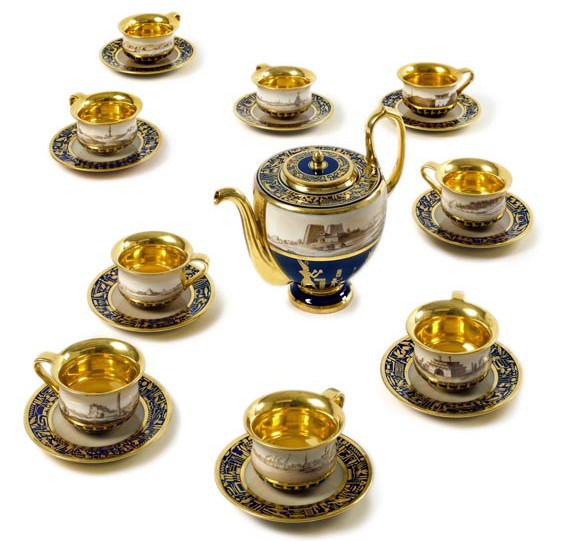Part of an Egyptian tea service, composed of a teapot and nine teacups and saucers in the “Denon-Etruscan form”, all in a beautiful deep blue, decorated with gold hieroglyphics and vignettes representing various sights in Egypt.
On 7 January 1810, just three weeks after his divorce, Napoleon wrote to Josephine from his Palais des Tuileries: “I have ordered the production of a very beautiful porcelain service. On your designs it shall be very beautiful indeed.” With a budget of 30,000 francs, the divorced Empress immediately ordered a replica version of the Egyptian table service that she liked immensely, a service that the Emperor had sent as a diplomatic gift to the Tsar (today held in the Museum of Ceramics and the 18th Century on the Kuskovo Estate in Moscow). Before the new table service was delivered, and having returned one to the manufacturers because its style she judged too “severe” (today held at Apsley House, London), she received in the autumn of 1811 the tea service that would accompany it.
Between 1808 and 1813, the manufactory at Sèvres would produce no fewer than seven tea services, of which two went to the Empress; the first, costing 1,672 francs, was given to her by the Emperor on 29 December 1808 as a new-year’s gift (service n° 2, today held at the Musée de Malmaison), and the second, costing 1,984 francs, was given to her on 31 October 1811 (service n° 4, begun at the Sèvres manufactory on 5 December 1810, today held at the Fondation Napoléon). Originally composed of eighteen teacups and saucers in the “Denon-Etruscan style” (1,296 francs), an Egyptian tripod sugar bowl (180 francs), a ribbed Etruscan sugar pot (80 francs), a “Denon-Etruscan” teapot (150 francs), an Egyptian bowl or basin (150 francs), a trefoil-rimmed cream-jug (48 francs) and a lipped milk-jug in the Etruscan style (80 francs); only the teapot and half of the teacups and saucers remain. The majority are styled on the Greek vases that Denon himself actually sold to the King in 1785, the aim being to open up the manufacturers to the antique style, explaining thus the fact that a number of the pieces carry Denon’s name. The scenes represented on the service are: on the teapot, “Vue d’Edfou du Nord au Sud” (“View of Edfu from North to South”) and “Sépultures arabes à Zaoye” (“Arab burial monuments at Zaoye”); and on the nine teacups, “Calis ou Canal qui conduit l’Eau au Caire” (the Calis or Canal bringing water to Cairo”), “Vue d’Alexandrie” (“View of Alexandria”), “Tombeau des Mahometans” (“Tomb of the Mohammedans”), “Vue de Bénécê” (“View of Bahnasa”), “Vue de basse Egypte” (“View of Lower-Egypt”), “Antinoé vu du Nil” (“Antinopolis viewed from the Nile”), “Vue de la basse Egypte” (“View of Lower-Egypt”), “Village de Nagadi dans le désert” (“the village of Nagadi in the desert”), and “Pyramides de Ssakarah” (“Pyramids of Saqqara”). These designs are based on engravings taken from Vivant Denon’s Voyage dans la Basse et la Haute Egypte (Travels in Lower and Upper Egypt) which was published in 1802 (of which there is an original copy in the collection of the Fondation Napoléon]. The landscapes were painted between May and July 1810 by Nicolas-Antoine Lebel, active during the period 1804 to 1845, and the gilding, decoration and burnishing were completed between July and October by the ornemanist Pierre-Louis Micaud, active during the period 1794 to 1834. The majority of the cups are marked with the date “27 August”, whilst the teapot bears the date “27 September”. The service went on sale on 5 December 1810, priced at 1,984 francs.
Bernard Chevallier, Conservateur Général du Patrimoine (emeritus) [tr. and ed. H. D. W.]
October 2008
This tea service was exhibited as part of “Napoleon: Revolution to Empire” at the National Gallery of Victoria, Melbourne, Australia, in 2012, parts of it were present in France at the exhibition “Napoléon Ier ou la légende des Arts, 1800 – 1815“, at the Palais de Compiègne [24/04/2015 – 27/07/2015] and also in Belgium as part of the exhibition “Napoléon-Wellington: Destins Croisés“, at the Wellington Museum, Waterloo [21/03/2015 – 31/07/2015].
Between 7 September and 10 December 2017, the teapot and two of the cups and saucers can be seen at the Museum Herzog Anton Ulrich (Braunshweig, Germany) for the exhibition “Porcelaine royale. Napoleons Bedeutung für Sèvres und Fürstenberg”. Two other cups and saucers will be presented in Turin (Italy) from 28 October 2017 in the touring exhibition “Napoleon: The Five Faces of Triumph” (coproduction Fondation Napoléon/DOCA).


